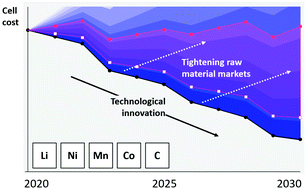Technological innovation vs. tightening raw material markets: falling battery costs put at risk†
Abstract
The reduction of battery costs is a key enabler for an economically viable transition towards a climate-neutral society. Despite market analysts being concerned about rising raw material prices, across forecasting studies, battery costs are expected to decline in the future. Respective authors base their cost estimates on past material price developments and do not rely on explicit technology roadmaps. This study integrates both future material price expectations and cost reductions driven by technological innovation. Therefore, a roadmap is defined for automotive battery technology and its production process throughout 2030, based on market expectations and expert knowledge. This roadmap is translated into year-over-year cell cost by two engineering-based, bottom-up material and process cost models and, at current raw material prices, a decline from above 100 to around 70 $ kW h−1 in 2030 is forecasted. The simulation of analysts’ price expectations for critical materials reveals that this decline might significantly flatten or, in the most pessimistic case, vanish completely. A particularly high risk for cell cost is associated with the nickel price and consequently, implications for research and industry are outlined for its mitigation.

- This article is part of the themed collections: Energy Advances: Highlight UK & Europe, Energy Advances – 2022 Outstanding Papers and Energy Advances 2022 Hot Papers


 Please wait while we load your content...
Please wait while we load your content...